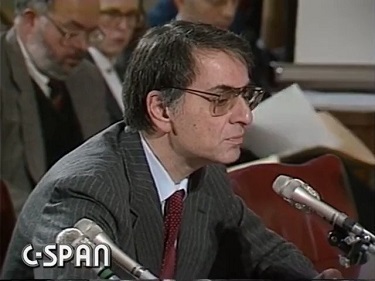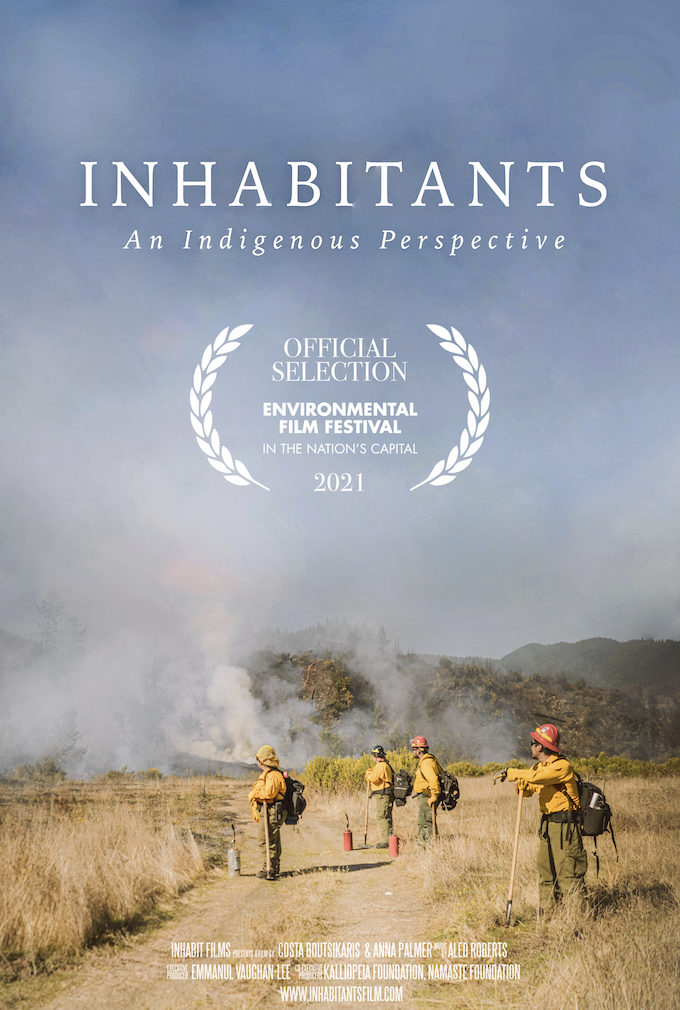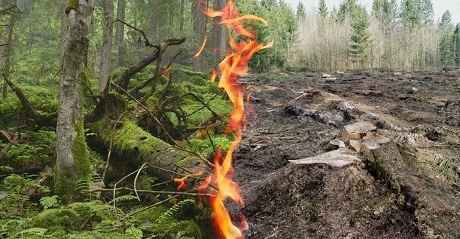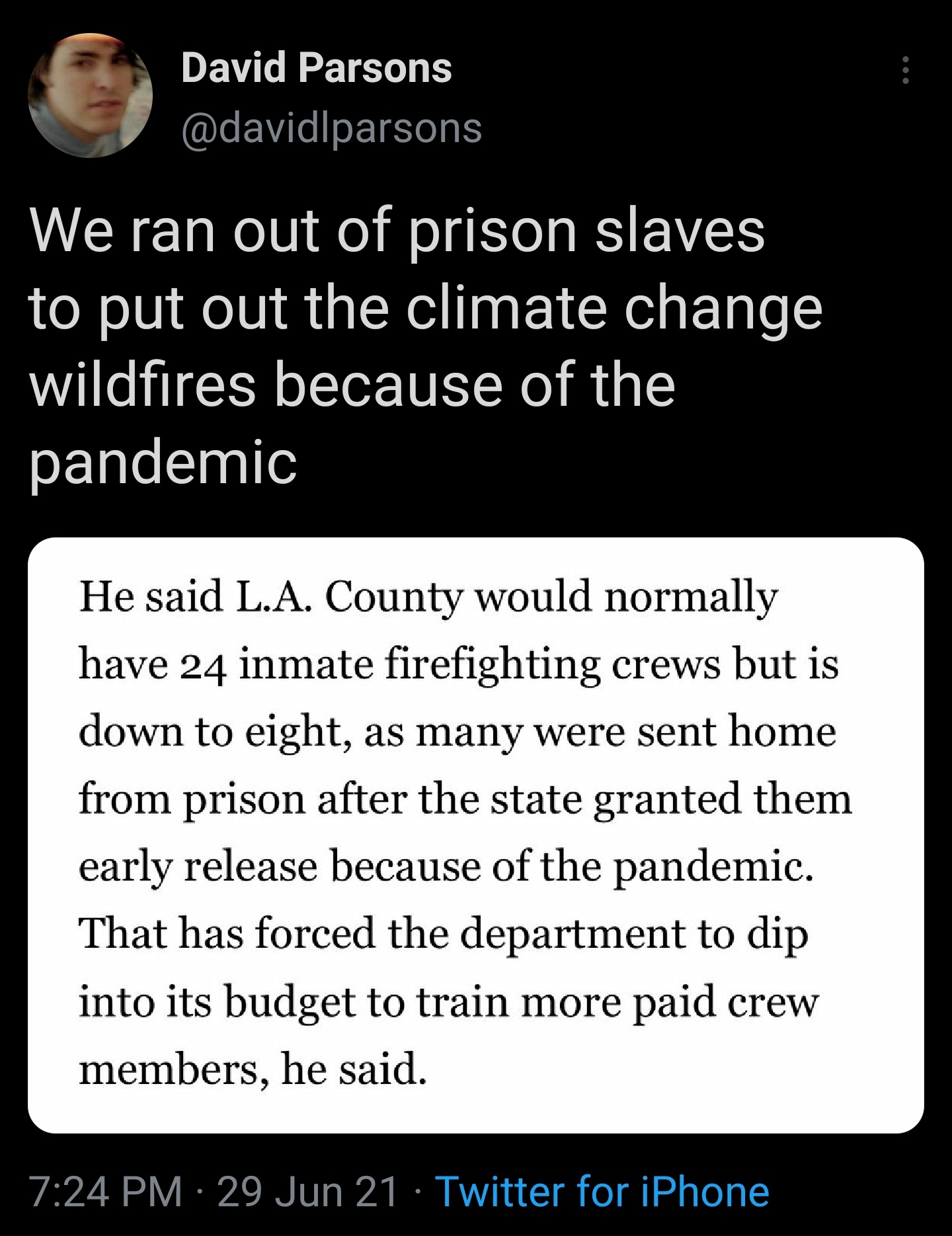
"They" can remotely turn off your EV... But they would never remotely cause it to burst into flames in your garage while you slept upstairs...
Couchcoughstuxnet...
7 Likes
9 Comments

"They" can remotely turn off your EV... But they would never remotely cause it to burst into flames in your garage while you slept upstairs...
Couchcoughstuxnet...

https://yewtu.be/watch?v=Wp-WiNXH6hI
#CarlSagan #testifying #congress #1985 #climate-change #environment #global #greenhouse-effect #alternative #energy #climateaction #global #consciousness
Can you imagine if they had listened to him?
Almost three quarters of the water is gone from Great Salt Lake. This is a double-nightmare because the land exposed by the receding water is creating dust laced with heavy metals like arsenic and copper from old mining operations, that the water had successfully "trapped".
#environmentalism #global-warming #climate-change #science #oligarchy
https://twitter.com/Gritty20202/status/1555604117887787015
Exxon's supporting Biden's climate plan tells you everything you need to know about it's potential effectiveness.
— Gritty is the Way (@Gritty20202) August 5, 2022
“We cannot solve climate change or other major symptoms of overshoot – biodiversity loss, tropical deforestation, overfishing, land and soil degradation, pollution of everything, the possibility of pandemics, etc., in isolation from the others. However, if we reverse overshoot, all its symptoms would be alleviated simultaneously.
–Bill Rees
#climate-change #energy-use #pandemic #environment #pollution #population #crisis #overshoot
https://www.artberman.com/2022/01/05/the-climate-change-trip-to-abilene/
Hey everyone, I’m #newhere. I’m interested in #activism, #analytical-philosophy, #anarchism, #anarcho-syndicalism, #animals, #anti-racism, #aoc, #bds, #bernie, #blm, #buddhism, #chomsky, #climate-change, #colombia, #critical-race-theory, #democratic-socialism, #environment, #first-nations, #global-warming, #green, #haiti, #hawaii, #humanism, #indigenous, #jacobin-mag, #matt-stoller, #Meditation, #metta, #palestine, #peace-studies, #progressive-and-liberal-politics, #santander-colombia, #social-science, #socialism, #sri-lanka, #state-crime, #syracuse, #syracuse-orange, #systemic-racism, #tibetan-buddhism, #TM, #us-crimes, and #veggie.

“Our #livelihoods #depend on a #planet that is not on #fire. We are an #Arctic #people and our #culture is written in #snow. But #climate-change means the snow will get less and less. We must realise we can’t #overconsume our planet. This is #urgent. We need to #listen to all the #indigenous people in the #world who know how to #live in #harmony with the planet.”
#sami #reindeer #herders #polar #region #europe #norway #finland #sweden #russia #climate #disaster #environment #ejf #nature #extreme #weather #farming #animals

Inhabitants: An Indigenous Perspective is a feature-length documentary that follows five North American tribes restoring their ancient relationships with the land while adapting to today’s climate crisis.
The film travels across diverse bioregions of North America, from deserts and coastlines, to forests, mountains, and prairies, highlighting the dramatic effects of climate change and stories of indigenous land stewardship practices, which continue to be resilient in the face of a changing climate. The film focuses on five stories: the return of prescribed fire practices by the Karuk Tribe in California; the restoration of buffalo on the Blackfeet reservation in Montana; sustained traditions of Hopi dryland farming in Arizona; sustainable forestry on the Menominee reservation in Wisconsin; and the revival of native Hawaiian food forests in Hawaii.
Although these stories are not connected geographically, and only represent a small portion of the many diverse indigenous communities leading efforts to maintain their cultural practices and identity, they all share the common dimensions of “traditional knowledges.” According to Guidelines for Considering Traditional Knowledges in Climate Change Initiatives,"[traditional knowledges] broadly refer to indigenous communities’ ways of knowing that both guide and result from their communities members’ close relationships with and responsibilities towards the landscapes, waterscapes, plants, and animals that are vital to the flourishing of indigenous cultures."
Climate change poses an immediate threat to Indigenous Peoples’ health, well-being and ways of life. Tribal nations are on the front lines of confronting climate change, including increased frequency and intensity of wildfires, higher temperatures, ecosystem changes, ocean acidification, forest loss, and habitat damage. Climate change also raises questions about what will become of spiritually and culturally significant ecosystem services that are essential to maintaining many tribes’ identities. Indigenous communities are disproportionately harmed by the changing climate as they depend more on natural resources than the US population as a whole. Negative impacts include threats to traditional foods such as fish and crops which have provided sustenance as well as cultural, economic, medicinal, and community health for countless generations.
Emerging threats have galvanized a concerted effort by several tribes to forge ahead with climate-change adaptation strategies. They are leading the way guided by indigenous traditions and are quickly adapting to and even directly counteracting the shifting climate. Examples like the Hopi dry land farming techniques show how to deal with extremely arid and hot weather; the raising of Native Bison on the prairie lands of the Midwest improves carbon sequestration while removing the need for feedstocks; and forest fire management that is being guided by native forestry practices are just a few of the stories that give insight into how much wisdom and importance the indigenous land use practices reflect; and how crucial it is that their story is heard. The indigenous land management practices in the forests, deserts, prairies and coastlines of North America have much to offer to the current conversation surrounding climate adaptation and mitigation.
The First Peoples are estimated to have lived in North America for 15,000 years. In a few short centuries Native Americans have had most of their population systematically erased, almost all their land taken, and also been forced to deal with the disastrous effects of industrialization on their remaining resources. Tribal communities have proven to be remarkably resilient, surviving in some of the most extreme environments and having endured very aggressive marginalization. We can now create a platform for helping these marginalized people share their wisdom about how to live in these lands and how their history and tradition can inform and guide us. This documentary is an effort to give Native Americans an opportunity to share their stories of resilience and wisdom in the face of extreme climatic stress. We as a society can listen and learn from these stories of time tested land use practices. Now is the moment to support Native peoples in becoming leading voices on how to design, create, imagine and live in a more sustainable and resilient world.
This past fall we had the honor of documenting the prescribed fire traditions of the Karuk Tribe in Northern California and the sustainable forestry operations of the Menominee Tribe in Wisconsin. These stories are being woven into a feature length documentary Inhabitants due out in 2020. Folks have been asking a lot about the Woodlanders series and although I took a break last summer to focus on this feature film we are ramping up for a new season of short films starting in the Pacific Northwest next month. Thanks for your patience and support. — Costa Boutsikaris (2019)
#Woodlanders is an online film series that seeks to document the work of people who care for and depend on forests for their livelihood and well-being throughout the world.
Even among today’s progressive movements of local economy and food systems, the vast global knowledge of forest livelihoods and economies are mostly undervalued and undocumented. From woodcraft and nut tree cultures of ancient Europe, to mushroom and forest medicines of Asia, there many fascinating ways of creating sustainable economies from the forests while maintaining their ecological health and complexity. While filming Inhabit - A Permaculture Perspective I fell in love with woodland cultures and felt called to research further. Over the past year I began to create an accessible archive of these stories and I hope to share this inspiring world with you. Sustainable relationships with forests regenerate and protect these wild places while also offering livelihoods to humans. Each episode will focus on a person or culture who has a sustainable relationship and/or livelihood with a forest. Join me on the journey and learn how much forests can offer. — Costa Boutsikaris
#Inhabitants #documentary #film #nature #environment #climate #FirstPeoples #IndigenousPeoples #tribal #lands #community #people #climate-change #land #reservations #land-use #aboriginal #management #fires #bushfires #wildfires #forestry #dryland #farming #food #food-growing #well-being #wisdom #way-of-life #culture #tradition #food #food-growing #practices #natural #resources #ecology #stewardship #knowledge #education #adaptation #Karuk #Blackfeet #Hopi #Menominee #Hawaii #TraditionalEcologicalKnowledge #conservation #protection #preservation #sustainability #resilience #CostaBoutsikaris #InhabitFilms #docu-films
https://www.youtube.com/watch?v=VtBGQUSj37s
Together We Grow (2022) is a 40-minute documentary telling the story of Common Unity Project Aotearoa.
Introducing a thriving hub helping to build resilience into its local community by #growing, #sewing, #repairing, #sharing – you name it, Common Unity is doing it!
Too many of our communities, here and around the world, are facing #housing-crises, food-insecurity, social-isolation, and more. In addition, the multiple impacts of the Covid pandemic and #climate-change are current and ongoing. How can we most effectively confront these challenges, and help our communities thrive in an economic system that leaves many feeling trapped in poverty?
Founder Julia Milne and her team have created a completely replicable model for developing strong, connected, resilient communities – a model that could be put in place across thousands of communities in Aotearoa and millions of communities across the world. They’ve proven it can be done, this film was made to help them share the story!
#TogetherWeGrow #documentary #film #local #community #thriving #hub #food-growing #resilience #resilient-communities #JuliaMilne #HappenFilms #docu-films
https://vimeo.com/ondemand/passelandepictures
Dirt Rich shifts focus from greenhouse gas emissions to carbon draw down which is the only viable solution for reversing the effects of runaway global warming in a timely manner. Through exploration of geo-therapy strategies, Dirt Rich shines light on their value and beauty which undeniably are our last hope for protecting life as we know it on this challenged planet. Through regenerative agricultural practices, reforestation of abandoned land, protection/restoration of carbon rich wetlands and keystone species, Dirt Rich illustrates how implementing these strategies will return our atmosphere to safe levels of carbon while growing soil, our most precious resource.
The science is clear. Global warming is worse than predicted and we are now at a tipping point. Currently our CO2 levels are at 400 parts per million (ppm) putting us way over the safe level of 260 ppm. Even if we were to stop all fossil fuel use today, the climate effects will continue for the next 1000 years because much of that carbon is stored in the ocean and it takes that long for it to cycle out. The only chance we have to halt the effects of runaway global warming is to quickly draw carbon back down into the soils where it belongs. This not only sequesters the carbon but serves to revitalize our collapsed soils by allowing natural processes like photosynthesis and microbial growth to take back over. Scientists are predicting that on our current trajectory we have 70 harvests left and a very short window of time to make the impactful changes necessary to prevent runaway global warming. Dirt Rich will illustrate for viewers the strategies necessary to accomplish this.
Dirt Rich takes the viewer on a journey through a multiplicity of carbon draw down strategies that focus on natural solutions that simultaneously address the revitalization of soil and stabilization of atmospheric carbon levels. Currently the planets soils are desperately depleted as the microbial life within them has been greatly destroyed. Scientists are predicting that on the current trajectory there is only enough good soil to support 64 more harvests. This film couldn’t be more timely. Through regenerative agricultural practices, reforestation of abandoned land, protection and the restoration of carbon rich wetlands, Dirt Rich educates and inspires viewers to contemplate how our choices matter, and how everything on this planet connects.
#DirtRich #documentary #film #nature #environment #pollution #fossil #fuel #global-warming #climate-change #soil #carbon #resources #reforestation #protection #restoration #regenerative #practices #MarcelinaCravat #PasselandePictures #docu-films
"Yeah, Australia, stop selling us your coal" we're trying to! @.@ but are guided by His light. Which is fuelled by briquettes, apparently.
https://www.abc.net.au/news/2021-08-20/climate-change-ipcc-australia-uk-conference-glasgow/100392252
from 2011 foreign ownership
and wiki re who's mining the coal Hint: Not us XD
the NSW Health Minister, while talking about a virus, suffered a bout of Bell's Palsy (caused by a virus. The gods are children) "It's not the first time Mr Dominello's health has made headlines. In 2019 it was reported he broke a bone while arm wrestling with state Attorney-General Mark Speakman." NSW has a more gladiatorial approach to politics than Vic ("Glad"iatorial HEH!)
and Melbourne's cutest Dads are doing well
https://www.abc.net.au/news/2021-08-20/gentoo-penguin-same-sex-couples-at-sea-life-melbourne-aquarium/100390002 bruhs! \m/
Scotty's invisible friend, the paedoGod, says no?
https://www.abc.net.au/news/2021-08-10/ipcc-scott-morrison-climate-change-net-zero-2050/100364476

The #Ice Is #Melting
The #Land Is #Burning
The #Ocean Is #Dying
The #Living #Planet Is #Unravelling
It's happening on our watch.
No more delays ...
#Climate #scientists around the world are alarmed by a triple climate-change-related crisis that hit the western U.S. and Canada in June and July.
Normally climatologists are careful in their assessment of extreme weather events, under pressure from energy industry profiteers and anti-science climate change deniers. They go to great pains to avoid being accused of exaggeration, and rarely (really never) point to climate change as the cause of specific freakish #weather events.
The severity of what has happened in June and July has pushed past many of their carefully calculated projections. The fingerprints of capitalist-induced global warming are all over the crime scene.
A severe #drought in the western states of the U.S. that has been worsening for months has nearly drained Lake Mead in Nevada, Lake Oroville in California and other major reservoirs, threatening #power #generation for millions of people. A series of intense, widespread, sustained heat waves tortured a quarter of the U.S. as well as western Canada for weeks, taking the lives of hundreds of people.
The super-dry conditions in the region have caused 83 wildfires, including the Dixie Fire in northern California and the Bootleg Fire in southern Oregon. They are two of the largest #wildfires in #history and are both still raging.
Mild Pacific Northwest goes wild
The southwest U.S. is no stranger to deadly heat, but what is most unexpected is that this extreme heat has hit the Pacific Northwest, a region known for mild temperatures and damp weather.
Roads buckled in Seattle from the sweltering heat. For several days Portland, Ore., was the fourth-hottest place on earth. British Columbia suffered the highest death toll with more than 800 deaths between the end of June and middle of July — quadruple the average number of deaths.
The village of Lytton in British Columbia burned to the ground just as Paradise, Calif., did in 2018 — essentially nothing left but ashes and smoke.
In Canada’s British Columbia province, and the U.S. states of Washington, Oregon and northern California, the heat broke all-time temperature records, and then broke those records again, and then again.
Electric power for millions threatened
Nevada and California’s livability depends on a system of 1,500 human-made reservoirs, not only for drinking water and agriculture but for electricity from hydroelectric generators.
Engineers say that the water level in Lake Mead will be below the minimum water level needed to generate power to 1.3 million people in a matter of days. Lake Oroville will likely last until September, when it won’t be able to supply electricity for another 800,000.
Normally, power companies buy power from nearby regions when needed. But constantly running air conditioning in a wide swath of the western U.S. during 2021 has diminished power surpluses that normally allow that to happen.
All told, the fires have burned 1.3 million acres — an area larger than Los Angeles, New York City and Chicago combined. The smoke has journeyed cross-country to the East Coast, prompting air quality warnings along the northern part of the Eastern Seaboard and as far inland as central Virginia.
In addition to California, Oregon, Washington and British Columbia, the heatwaves hit Nevada, Arizona, New Mexico, Utah, Colorado, Wyoming, Montana and Idaho.
Heat deadly for agricultural workers
Thirty-eight-year-old Sebastián Francisco Pérez from Guatemala was working at an Oregon tree farm on June 26 when he collapsed and died from the heat. The Bureau of Labor Statistics reports that 53 #agricultural #workers died from heat nationwide in 2019, but this was the first in Oregon directly attributable to heat.
Only four states have laws in place to protect farmworkers. Oregon became the third after the death of Sebastián. Washington State quickly followed with some emergency measures. Some other states merely have “guidelines.”
Irene Ruiz, an #environmental #justice organizer from Boise, Idaho, messaged about the heightened danger to agricultural workers during heatwaves. “Guidelines are not enough. These are the people who put food on our tables and are the most affected and in danger of extreme heat.”
#Imperialism and #globalwarming
Recent decades have seen extreme weather events become more frequent and much more severe than previous periods. Experts point to that quickening pace and increasing severity as caused directly by global warming, even though they usually avoid blaming global warming for specific weather events.
The opposing narrative, motivated by energy profiteers, is that the warming of the atmosphere during this period is a natural cycle, that it has happened before over the millennia, and that it will pass.
But a #scientific #paper published in the journal Nature on July 28 referenced two large, decades-long studies of the #Earth’s “ #energy balance” — the amount of the sun’s energy entering Earth’s atmosphere compared to the amount of energy reflected back out into space. Both studies confirm that greenhouse gases are keeping the sun’s energy trapped in our atmosphere.
The paper asserts that there is less than a 1% chance that the rise in global temperatures and all of its frightening consequences are a natural occurrence.
#Greenhouse #gases began to heat the #atmosphere with the dawn of #industrial #capitalism in the latter part of the 19th century. That much is readily admitted in the capitalist press these days. What isn’t written about enough is the role of imperialist domination in this crisis for #humanity.
The machinery of war is the greatest consumer of oil, and like a dog chasing its tail, pollutes the world while fighting to control oil markets. If the #US military machine were to be ranked in the list of countries that indicates how much they contribute to pollutants that heat the atmosphere, the list would show it ahead of 46 countries.
Estimates of the cost of stopping global warming vary from $300 billion to Forbes Magazine’s price tag of $50 trillion. Underdevelopment and poverty have been imposed on much of the world by #imperialist #military #force and #economic #leverage for more than a century. The stolen wealth is now concentrated in the hands of the tiny group of billionaires that have profited immensely — as a class — from the control of oil markets. That stolen wealth is key to mitigating climate change.
The world is being told to put its faith in international agreements to solve the crisis. The #ParisClimateAgreement is supposed to oblige each participating country to limit greenhouse gases and commit rich nations — and in some cases private corporations — to help fund efforts by poor nations with $100 billion per year in grants, loans and other forms of financing, to help them switch to clean energy.
That agreement still shifts the blame to the poorest countries, when in fact 20 industrialized countries are responsible for 78% of greenhouse gases.
Historically, no country has put more carbon dioxide into the air than the imperialist U.S. #empire. The ultimate goal of the Paris Agreement is to limit greenhouse gases to a 2% increase per year, and “if possible” to 1.5% per year. As of today, the rich countries haven’t come up with the first $100 billion that was due in 2018.
https://climate.copernicus.eu/surface-air-temperature-july-2021
#Capitalism is a #roadblock on the path to mitigating this huge crisis for #humankind. It will take a #global #environmental #movement that is #revolutionary — #conscious of the need to #eradicate imperialism — to stop the crisis of global warming and climate change ~
#scottscheffer #climate-emergency #climate-action #climate-crisis #climate-change #climate-strike
(literally ‘Humanity killing itself’) is a short abstract film that proceeds from the premise that consumer capitalism, exemplified by ubiquitous commodification, necessarily conditions society to indulge in Hedonism, the consequence of which will be the destruction of the environment upon which we depend for life and the subsequent demise of the human race.
https://vimeo.com/578500714
#climate_cridsis, #climate-change, #global_warming, #ecotastrophe, #anthropocide, #eco-activism, #environmentalism, #COP26, #activism, #short_film, #art, #permaculture, #commodification, #consumer_capitalism

https://www.youtube.com/watch?v=JuOeQkpNs-g
https://t.co/sbO1d4GkrX
https://alfredodifilippo.com/2021/07/10/forests-and-nature-based-solutions-address-the-climate-change-and-biodiversity-emergencies-together/
https://www.greenpeace.org/eu-unit/issues/nature-food/45768/5-reasons-why-burning-trees-for-energy-is-bad-for-climate-people-and-nature/
You can #plant #trees, but you cannot plant #forests. Forests are not #renewable. Here’s a #letter to #EU #officials from #62 #global #scientists on the #issue #nature-based-solutions address the #climate-change and #biodiversity #emergencies #together
#StopFakeRenewables #sign #petition #UniteBehindTheScience #ClimateJustice #UprootTheSystem #FightFor1Point5

#fire-fighters #prison #slaves #pandemic #climate-change #LosAngeles #county #budget